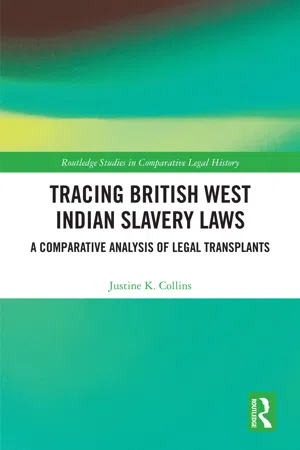
Tracing British West Indian Slavery Laws
A Comparative Analysis of Legal Transplants
Justine K. Collins
- 240 pages
- English
- ePUB (adapté aux mobiles)
- Disponible sur iOS et Android
Tracing British West Indian Slavery Laws
A Comparative Analysis of Legal Transplants
Justine K. Collins
À propos de ce livre
This book provides a legal historical insight into colonial laws on enslavement and the plantation system in the British West Indies.
The volume is a work of comparative legal history of the English-speaking Caribbean which concentrates on how the laws of England served to catalyse the slavery laws and also legislation pertaining to post-emancipation societies. The book illustrates how these "borrowed" laws from England not only developed colonial slavery laws within the English-speaking Caribbean but also inspired the slavery codes of a number of North American plantation systems. The cusp of the work focuses on the interconnectivities among the English-speaking slave holding Atlantic and how persons, free and unfree, moved throughout the system and brought laws with them which greatly affected the various enslaved societies.
The book will be essential reading for students and researchers interested in colonial slavery, Caribbean studies and Black and Atlantic history.
Foire aux questions
Informations
1 The origins of legal transplantation within the British West Indies (British Caribbean), 1500s–1700s
The English and European expansionism
Whereas our well beloved and faithfull Cousin and Councillor James Hay Baron of. … Doncaster and Earle of Carlisle having laudable and zealous care to increase Christian Religion and to inlarge the territories of our Empire in certaine lands situated to … northward Region of the World which Region or Islands hereafter described … before were unknown and by certaine barbarous men having no knowledge of the divine power in some part possessed commonly called the Charibbee Islands.99 Ibid.
Table des matières
- Cover
- Half Title
- Series
- Title
- Copyright
- Contents
- Introduction
- 1 The origins of legal transplantation within the British West Indies (British Caribbean), 1500s–1700s
- 2 The origins of slavery laws within the British West Indies, 1600s
- 3 The comprehensive slavery codes of the British West Indies and their reverberations, 1660s–1700s
- 4 The role of legal transplantation within manumission law and other ameliorative measures
- 5 Legal transplantation within post-emancipatory British West Indies, 1830s–1870s
- Conclusion
- Index